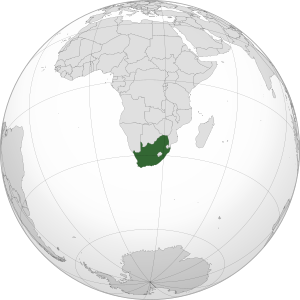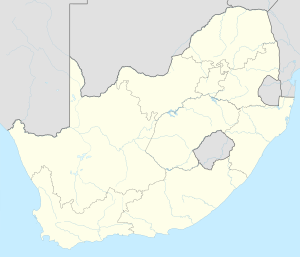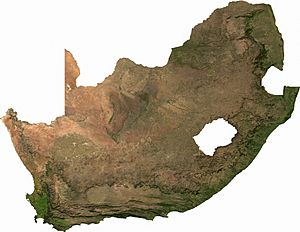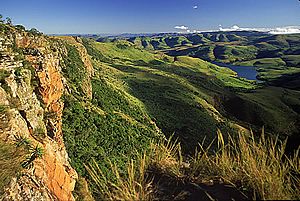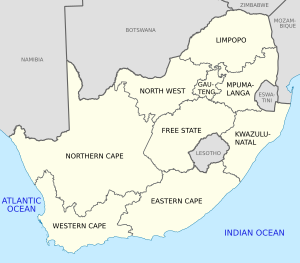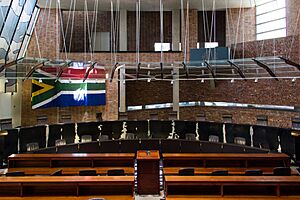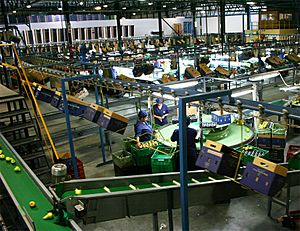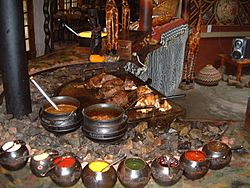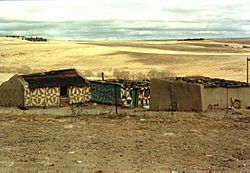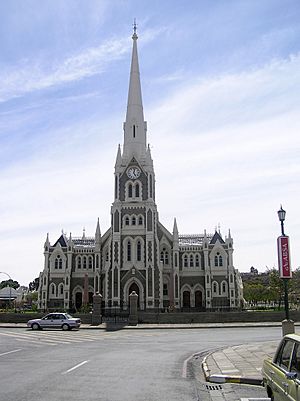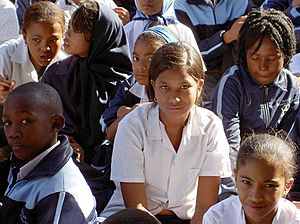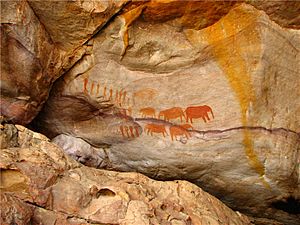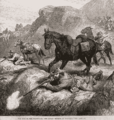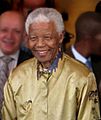South Africa facts for kids
Quick facts for kids
Republic of South Africa
11 other official languages
|
|||||||||||||||||||||
|---|---|---|---|---|---|---|---|---|---|---|---|---|---|---|---|---|---|---|---|---|---|
|
|
|||||||||||||||||||||
|
Motto: "ǃke e: ǀxarra ǁke" (ǀXam)
"Unity in diversity" |
|||||||||||||||||||||
|
Anthem: "National anthem of South Africa"
|
|||||||||||||||||||||
| Capital |
|
||||||||||||||||||||
| Largest city | Johannesburg | ||||||||||||||||||||
| Official languages | 12 languages
|
||||||||||||||||||||
| Ethnic groups
(2022)
|
|
||||||||||||||||||||
| Religion
(2022)
|
|
||||||||||||||||||||
| Demonym(s) |
|
||||||||||||||||||||
| Government | Unitary parliamentary republic with an executive presidency | ||||||||||||||||||||
| Cyril Ramaphosa | |||||||||||||||||||||
| Paul Mashatile | |||||||||||||||||||||
|
• Speaker of the National Assembly
|
Thoko Didiza | ||||||||||||||||||||
| Legislature | Parliament | ||||||||||||||||||||
| National Council of Provinces | |||||||||||||||||||||
| National Assembly | |||||||||||||||||||||
| Independence
from the United Kingdom
|
|||||||||||||||||||||
|
• Union
|
31 May 1910 | ||||||||||||||||||||
| 11 December 1931 | |||||||||||||||||||||
|
• Republic
|
31 May 1961 | ||||||||||||||||||||
|
• Current constitution
|
4 February 1997 | ||||||||||||||||||||
| Area | |||||||||||||||||||||
|
• Total
|
1,221,037 km2 (471,445 sq mi) (24th) | ||||||||||||||||||||
|
• Water (%)
|
0.380 | ||||||||||||||||||||
| Population | |||||||||||||||||||||
|
• 2022 census
|
62,027,503 (23rd) | ||||||||||||||||||||
|
• Density
|
50.8/km2 (131.6/sq mi) (169th) | ||||||||||||||||||||
| GDP (PPP) | 2024 estimate | ||||||||||||||||||||
|
• Total
|
|||||||||||||||||||||
|
• Per capita
|
|||||||||||||||||||||
| GDP (nominal) | 2024 estimate | ||||||||||||||||||||
|
• Total
|
|||||||||||||||||||||
|
• Per capita
|
|||||||||||||||||||||
| Gini (2014) | ▼ 63.0 very high |
||||||||||||||||||||
| HDI (2022) | high · 110th |
||||||||||||||||||||
| Currency | South African rand (ZAR) | ||||||||||||||||||||
| Time zone | UTC+2 (SAST) | ||||||||||||||||||||
| Date format | Short formats:
|
||||||||||||||||||||
| Driving side | left | ||||||||||||||||||||
| Calling code | +27 | ||||||||||||||||||||
| ISO 3166 code | ZA | ||||||||||||||||||||
| Internet TLD | .za | ||||||||||||||||||||
South Africa is a country located at the very bottom tip of Africa. It has a long coastline along two oceans: the South Atlantic and the Indian. South Africa is known for its diverse cultures, many languages, and beautiful natural landscapes. It is also famous for its wildlife, including lions, elephants, and rhinos.
Contents
- South Africa's History
- Exploring South Africa's Geography
- South Africa's Biodiversity
- South Africa's Provinces
- Government and Politics in South Africa
- South Africa's Economy
- South Africa's Population
- South African Society
- South African Culture
- South Africa's Military
- Related pages
- Images for kids
- See also
South Africa's History
The first European explorers to reach South Africa were from Portugal in 1487. Bartolomeu Dias found a stormy cape, which the king of Portugal later named the "Cape of Good Hope". This name showed new hope for finding a sea route to India.
In 1652, Jan van Riebeeck started a colony at the Cape for the Dutch East India Company. This camp provided fresh food for ships traveling to Asia. Since there were few local people, slaves were brought from Indonesia, Madagascar, and India to work there. In 1795, Great Britain took control of the Cape to prevent France from getting it. The British gave it back in 1803 but then took it again in 1807 when the Dutch East India Company went bankrupt.
In 1867, Diamonds were discovered in South Africa, and Gold was found in 1884. These discoveries brought many people from Europe, hoping to get rich.
The First Boer War took place from 1880 to 1881 between the British and the Boers. The Boers were descendants of Dutch settlers who had moved north during the Great Trek. The British lost this war but returned in 1899 for the Second Boer War. This time, with more soldiers, the British won in 1902. On May 31, 1910, the Union of South Africa was formed. It combined the Cape and Natal colonies with two Boer Republics, the Orange Free State and the Transvaal.
Exploring South Africa's Geography
South Africa is located at the southernmost part of Africa. It has a long coastline, stretching over 2,500 kilometers (1,550 miles), along both the South Atlantic and Indian oceans. South Africa is the 25th largest country in the world, covering about 1,219,912 square kilometers (471,443 square miles). The highest point in South Africa is Njesuthi in the Drakensberg mountains, which stands at 3,408 meters (11,181 feet) tall.
Most of South Africa's interior is a large, flat area called the Karoo. This scrubland is quite dry, especially towards the northwest, near the Namib desert. However, the eastern coastline gets a lot of water, giving it a climate similar to tropical regions.
North of Johannesburg, the land drops down from the Highveld plateau into the lower Bushveld. This area has mixed dry forests and lots of wildlife. East of the Highveld, the Lowveld stretches towards the Indian Ocean. It has warm temperatures and is good for agriculture.
South Africa's Climate
South Africa generally has a mild climate. It is surrounded by the Atlantic and Indian Oceans on three sides. The land's height changes a lot, and the oceans influence the weather. This means different parts of South Africa have different climates.
The far northwest has a desert climate, like the southern Namib. The east, along the Mozambique border and Indian Ocean, has a subtropical climate. From the east, the land quickly rises over mountains to a high plateau called the Highveld. Even though South Africa is often seen as dry, its climate and land features vary greatly.
The southwest has a climate like the Mediterranean. It has mild, wet winters and hot, dry summers. This region is famous for making much of South Africa's wine. It is also known for its strong winds, which can be dangerous for sailors around the Cape of Good Hope. Further east along the south coast, rain falls more evenly throughout the year, creating a green landscape known as the Garden Route.
The Orange Free State is mostly flat because it is in the center of the high plateau. North of the Vaal River, the Highveld gets more rain and avoids the subtropical heat. Johannesburg, in the middle of the Highveld, is about 1,740 meters (5,709 feet) high and gets about 740 millimeters (29.9 inches) of rain each year. Winters here are cold, but snow is rare.
South Africa's Biodiversity
South Africa is one of the world's 17 "megadiverse" countries. This means it has an incredibly wide variety of plants and animals.
Amazing Animals of South Africa
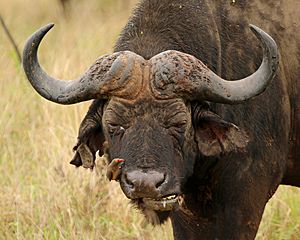
Many mammals live in the Bushveld region. These include lions, African leopards, South African cheetahs, southern white rhinos, blue wildebeest, kudus, impalas, hyenas, hippopotamuses, and South African giraffes. A large part of the Bushveld is in the northeast, home to Kruger National Park and the Sabi Sand Game Reserve. South Africa also has many unique species found nowhere else, like the critically endangered riverine rabbit (Bunolagus monticullaris) in the Karoo.
Unique Plants of South Africa

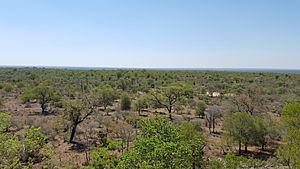
South Africa is incredibly rich in plant life, with over 22,000 different types of higher plants. This is about 9% of all known plant species on Earth! The most common type of natural area in South Africa is the grassland, especially on the Highveld. Here, you'll find many different grasses, small shrubs, and acacia trees like the camel-thorn (Vachellia erioloba).
Towards the northwest, plants become scarcer due to low rainfall. In the very hot and dry Namaqualand area, there are many succulents that store water, such as aloes and euphorbias. The grass and thorn savannah slowly changes into a bush savannah in the northeast, with thicker plant growth. This area, near the northern part of Kruger National Park, has many baobab trees.
The fynbos biome is found in a small part of the Western Cape. It is one of the six floral kingdoms and has over 9,000 plant species, making it one of the richest plant areas on Earth. Most fynbos plants are evergreen with tough, needle-like leaves. Another unique South African plant group is the Protea, with about 130 different species.
Even with all this plant diversity, only about 1% of South Africa is covered by forests. These are mostly found in the humid coastal plain of KwaZulu-Natal, where you can also find Southern Africa mangroves in river mouths. There are also smaller forests in areas protected from fire, called montane forests. Most large tree plantations in South Africa are made up of imported trees like eucalyptus and pine.
South Africa's Provinces
South Africa is divided into 9 provinces. These provinces are then split into 52 districts. Eight of these are large city areas (metropolitan municipalities), and 44 are district municipalities. The district municipalities are further divided into 226 smaller local municipalities.
Government and Politics in South Africa

South Africa is a parliamentary republic. This means that the president is both the head of state (the country's official representative) and the head of government (the leader of the government). The president's job depends on the support of the Parliament.
The government has three main parts:
- The executive (the president and cabinet)
- The legislature (Parliament, which makes laws)
- The judiciary (the courts, which interpret laws)
All these parts must follow the Constitution of South Africa, which is the highest law in the country. The courts can even cancel government actions or laws if they go against the Constitution.
Parliament has two houses:
- The National Assembly (the lower house) has 400 members. They are elected every five years.
- The National Council of Provinces (the upper house) has 90 members. Each of the nine provincial legislatures chooses ten members.
After each election, the National Assembly chooses one of its members to be president. A president can serve for a maximum of two terms, each lasting normally five years. The president then chooses a deputy president and ministers to form the cabinet. The National Assembly can remove the president and cabinet if they lose confidence in them.
South Africa does not have one single capital city. Instead, its three government branches are in different cities:
- Cape Town is the legislative capital, where Parliament meets.
- Pretoria is the administrative capital, where the president and cabinet work.
- Bloemfontein is traditionally the judicial capital, home to the Supreme Court of Appeal. However, the highest court, the Constitutional Court of South Africa, has been in Johannesburg since 1994.
Most foreign embassies are located in Pretoria.
South Africa's Economy
South Africa's economy is quite unique because it has both very modern parts and less developed parts. The modern part is similar to wealthy nations like Britain or Australia. The other part is more like the economies of developing countries.
The main industries in South Africa include:
- Mining (especially for gold and diamonds)
- Car manufacturing
- Service industries, such as insurance
South Africa faces some economic challenges. There are many people who do not have jobs. Also, there is a big difference in how much money people earn. However, policies have helped more black South Africans become part of the middle class, which is growing.
South Africa's Population
South Africa is home to about 62 million people. They come from many different backgrounds, with diverse cultures, languages, and religions. According to the 2022 census, the population is made up of:
- 81.4% Black
- 8.2% Coloured
- 7.3% White
- 2.7% Indian or Asian
- 0.4% other
The population of South Africa has been growing, partly due to people moving there from other countries.
South African Society
South Africa has many different ethnic groups, so there isn't just one "South African culture." However, people from all backgrounds enjoy the diverse foods, music, and dance. These are also popular with tourists.
South African food often includes a lot of meat. A popular social event is a braai, which is like a barbecue. South Africa is also a big wine producer, with beautiful vineyards in valleys around Stellenbosch, Franschhoek, Paarl, and Barrydale.
Many black South Africans still live in rural areas and face daily challenges. However, their cultural traditions are often very strong there. As more black South Africans move to cities and adopt modern lifestyles, some traditional customs have changed. City dwellers often speak English or Afrikaans, in addition to their native tongue. South Africa has 12 official languages, plus eight other officially recognized languages, including some Khoisan languages.
The middle class in South Africa, which used to be mostly white, now includes growing numbers of black, coloured, and Indian people. Their lifestyles are often similar to those in Western Europe, North America, and Australasia. Many in the middle class study and work abroad to gain experience in global markets.
Religion in South Africa
According to the 2001 national census, most South Africans are Christians, making up 79.7% of the population. This includes various Christian groups like Zion Christian (11.1%), Pentecostal (8.2%), Roman Catholic (7.1%), Methodist (6.8%), Dutch Reformed (6.7%), and Anglican (3.8%).
Other religions include:
About 15.1% of the population reported having no religious affiliation.
Education in South Africa
South Africa has a three-part education system:
- primary school
- high school
- tertiary education (like university)
Students typically have twelve years of formal schooling, from Grade 1 to Grade 12. Grade R, or Grade 0, is a pre-primary year that helps prepare children for school.
Primary schools cover the first seven years of schooling. High school education lasts for another five years. At the end of Grade 12, students take the National Senior Certificate (NSC) examination. Passing this exam is necessary to study at a South African university.
During the time of Apartheid, schools for black students faced unfair treatment. They received less money and had a different curriculum called Bantu Education. This system was designed to give them only enough skills to work as laborers, which was a form of discrimination.
South African Culture
South Africa's culture is a rich mix of many traditions. While many black South Africans have moved to cities and adopted modern ways, traditional customs remain strong, especially in rural areas. The middle class, which includes people of all races, often lives a lifestyle similar to those in Western countries.
Arts and Creativity in South Africa
South African art is very old, with some of the oldest art objects in the world found in a South African cave, dating back about 75,000 years. The Khoisan people, who moved into South Africa around 10,000 BC, had their own unique art styles, which can still be seen in many cave paintings. Later, the Bantu/Nguni peoples brought their own art forms.
New forms of art also developed in the mines and townships, using everyday materials like plastic strips and bicycle spokes. The folk art of the Dutch-influenced Afrikaner trekboers and the art of urban white artists, who followed European trends, also added to this diverse mix. This blend of art continues to grow and change today.
South African Literature
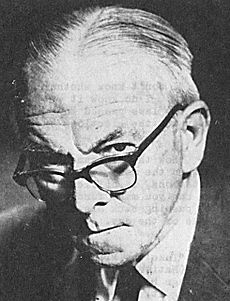
South African literature has a unique history shaped by its society and politics. One of the first well-known novels by a black author in an African language was Solomon Thekiso Plaatje's Mhudi, written in 1930. In the 1950s, Drum magazine became a popular place for political satire, stories, and essays, giving a voice to urban black culture.
Famous white South African authors include Alan Paton, who wrote Cry, the Beloved Country in 1948. Nadine Gordimer was the first South African to win the Nobel Prize in Literature in 1991. J.M. Coetzee also won the Nobel Prize in Literature in 2003. The Swedish Academy praised Coetzee for showing "the surprising involvement of the outsider" in his works.
The plays of Athol Fugard have often been performed in South Africa, London, and New York. Olive Schreiner's The Story of an African Farm (1883) was a groundbreaking book in Victorian literature, often seen as introducing feminism into novels.
Some writers faced challenges for their work. Breyten Breytenbach was jailed for his involvement in the movement against apartheid. André Brink was the first Afrikaner writer whose books were banned by the government after he published A Dry White Season.
Delicious South African Cuisine
South Africa's food is very diverse, with dishes from many different cultures. Everyone enjoys these foods, and they are especially popular with tourists who want to try the wide variety available. South African food is often meat-based and has led to a special social gathering called the braai, which is a type of barbecue. South Africa has also become a major wine producer, with some of the best vineyards located in valleys around Stellenbosch, Franschhoek, Paarl, and Barrydale.
Popular Sports in South Africa
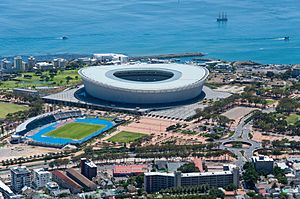
South Africa's most popular sports are association football (soccer), rugby union, and cricket. Other sports that many people enjoy include swimming, athletics, golf, boxing, tennis, rugby league, ringball, field hockey, surfing, and netball. While football is most popular among young people, sports like basketball, judo, softball, and skateboarding are also becoming more common.
Football is the most popular sport in South Africa. Famous footballers who have played for big international clubs include Steven Pienaar, Lucas Radebe, Philemon Masinga, Benni McCarthy, Aaron Mokoena, and Delron Buckley. South Africa hosted the 2010 FIFA World Cup, and the event was very successful. The national team, Bafana Bafana, won the 1996 African Cup of Nations. In 2022, the women's team also won the 2022 Women's Africa Cup of Nations, and reached the last 16 at the 2023 FIFA Women's World Cup.
Famous combat sport athletes include Baby Jake Jacob Matlala, Vuyani Bungu, Welcome Ncita, Dingaan Thobela, Corrie Sanders, Gerrie Coetzee, Brian Mitchell, and Dricus du Plessis. Surfer Jordy Smith from Durban won the 2010 Billabong J-Bay Open, becoming the world's top-ranked surfer. South Africa also produced Formula One motor racing's 1979 world champion Jody Scheckter. Well-known active Grand Prix motorcycle racing riders include Brad Binder and his younger brother Darryn Binder. Many active cricket players like Kagiso Rabada, David Miller, and Quinton de Kock also play in the Indian Premier League.

South Africa has produced many world-class rugby players, such as Francois Pienaar, Joost van der Westhuizen, Victor Matfield, Bryan Habana, and Siya Kolisi. The Springboks have won the Rugby World Cup four times, which is more than any other country. They won in 1995 (which they hosted), 2007, 2019, and 2023.
Cricket is another very popular sport in South Africa. The country hosted the 2003 Cricket World Cup and the 2007 World Twenty20 Championship. South Africa's national cricket team, the Proteas, won the first 1998 ICC KnockOut Trophy. In 2023, the women's team came in second place at the 2023 ICC Women's T20 World Cup, which South Africa hosted. The national blind cricket team also won the first Blind Cricket World Cup in 1998.
In 2004, the swimming team of Roland Schoeman, Lyndon Ferns, Darian Townsend, and Ryk Neethling won a gold medal at the Olympic Games in Athens, setting a new world record. Penny Heyns won Olympic Gold in 1996. More recently, swimmers Tatjana Schoenmaker and Lara van Niekerk have broken world records and won gold medals at the Olympics and Commonwealth Games. In 2012, Oscar Pistorius became the first double amputee sprinter to compete at the Olympic Games in London. Gary Player is considered one of the greatest golfers of all time, having won the Career Grand Slam.
South Africa's Military
South Africa's military is the strongest in southern Africa. The country spends more on its military than its neighbors, which means it has very advanced weapons. South Africa used to have nuclear weapons, but they were taken apart in 1993.
Related pages
- List of rivers of South Africa
- South African Grand Prix
- Antjie Krog
- Autshumato
- Breyten Breytenbach
- Cango Caves
- Azanian People's Organisation
- Dalene Matthee
- David Goldblatt
- Day of Reconciliation
- Dusi Canoe Marathon
Images for kids
-
Mapungubwe Hill, the site of the former capital of the Kingdom of Mapungubwe
-
Arrival of Jan van Riebeeck, who founded the first European settlement in South Africa, with Devil's Peak in the background
-
Boers in combat (1881)
-
Nelson Mandela, first black African President of Republic of South Africa
-
Important geographical regions in South Africa. The thick line traces the course of the Great Escarpment which edges the central plateau. The eastern portion of this line, coloured red, is known as the Drakensberg. The Escarpment rises to its highest point, at over 3000 m, where the Drakensberg forms the border between KwaZulu-Natal and Lesotho. None of the regions indicated on the map has a sharp well-defined border, except where the Escarpment, or a range of mountains forms a clear dividing line between two regions. Some of the better known regions are coloured in; the others are simply indicated by their names, as they would be in an atlas.
-
Houses of Parliament in Cape Town, seat of the legislature
-
Jacob Zuma, President of South Africa since 2009
-
SANDF soldiers
-
The JSE is the largest stock exchange on the African continent.
-
Mark Shuttleworth in space
-
Nederduits Gereformeerde Kerk in Wolmaransstad
-
Sangoma performing a traditional baptism in Alexandra, Johannesburg
-
Meat on a traditional South African braai
-
The Springboks in a bus parade after winning the 2007 Rugby World Cup
See also
 In Spanish: Sudáfrica para niños
In Spanish: Sudáfrica para niños




